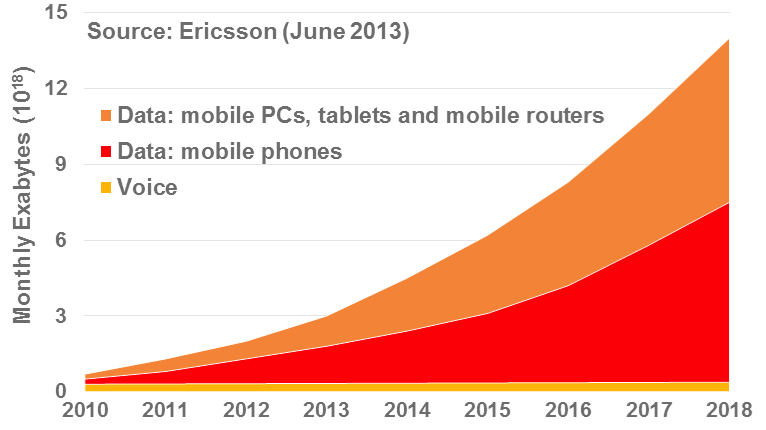Ericsson Report Means
HTS Poised to Benefit
Oct 31st, 2013 by
Jose Del Rosario, NSR
In the latest Ericsson
Mobility Report, key statistics
and future forecasts were
presented, which should provide
satellite technology,
specifically High Throughput
Satellites (HTS), with highly
promising short term
opportunities.
As of Q2 2013, 105 million
mobile subscribers were added to
the global total, which stands
at 6.5 billion mobile
subscribers, representing a
penetration level of 91%. By the
end of 2018, Ericsson expects
mobile subscriptions to reach
9.1 billion and for 60% of the
world's population to be covered
by Long Term Evolution (LTE)
technology.
The additional subscription
base of 2.6 billion in four
short years as well as the
deployment of LTE translates to
requirements for higher
bandwidth where all solutions
(including satellite-based
platforms) should begin to
support 3G and eventually 4G.
Ericsson further forecasts that
mobile data traffic will
grow by 12 times between 2012
and 2018.
Global
Mobile Traffic: Voice and Data,
2010-2018

Source:
Ericsson
In examining which satellite
platform works best to support
the upcoming surge in traffic
where a stable trend of data
growth means mobile data
subscriptions will grow
strongly, capacity cost
will undoubtedly be a key metric
in the solution mix.
In NSR’s view, HTS
platforms should emerge as the
preferred satellite solution
as they will not only serve as a
“better costing platform,” but
also help drive subscriptions as
they address the continuous
increase in the average data
volume per subscriber.
Data traffic is highly
asymmetrical compared to voice
where efficiencies can be gained
in terms of converting hertz to
bits. With the expected
continued explosion of data
traffic, satellite
capacity that runs on 3G and
even 4G platforms can be
supported with a reasonable ROI
using HTS.
Indeed, recent deals have
begun to reflect this. In August
2013, Intelsat and Japan-based
SoftBank Mobile announced the
successful trial of a
cost-effective, rural 3G mobile
phone service in Kenya. Intelsat
supported the demonstration
through capacity on Intelsat 10;
however, the demonstration is
aimed at delivering a managed
VSAT-based 3G solution through
the allocation of capacity via
the operator’s upcoming
EpicNG HTS platform for
the upgrade of networks from 2G
to 3G, and eventually to 4G via
satellite. In June 2013,
HTS operator O3b signed
a deal with Maju Nusa to provide
ultra-high speed 3G Backhaul
services across rural Malaysia.
Worth noting is that the deal
helps reduce CAPEX costs with
the aggregation of 111 sites
over Peninsular Malaysia into 20
customer terminal locations.
This does not mean,
however, that traditional FSS
capacity no longer has a play in
wireless backhaul. Even
if data is expected to outpace
voice traffic by leaps and
bounds, voice will continue to
be essential in provisioning
cellular and/or wireless
service. VoIP is certainly
available; however, quality of
service issues may lead to HTS
being restrained in terms of
growth prospects. A
solution may be to co-locate HTS
for data traffic and Traditional
FSS to serve voice in a single
terminal site.
Bottom Line
HTS solutions that
have the ability to support high
levels of data with lower cost
structures stand to benefit
tremendously from the
trends outlined by the Ericsson
report. In NSR’s view,
short-to-long term
projections of data usage can
only be achieved with the
participation of satellite
systems, given the high
levels of additional subscribers
being forecasted within a
four-year period and high levels
of data subscribers will demand.
Terrestrial networks cannot
wholly handle this upsurge in
both subscribers and data
traffic given wireless
spectrum is already at the
breaking point in many
countries.
Ericsson noted as well that
video traffic in mobile networks
is expected to grow by around
60% annually through 2018.
In NSR’s view, an
emerging backhaul application
may be to “offload” mobile video
in order to help decongest
terrestrial networks.
An emerging “video offload”
application could be a
substantial game changer for the
industry given that wireless
backhaul via satellite that has
been relegated in rural and
underserved areas may now be a
compelling proposition in
potentially decongesting urban
mobile networks.
|